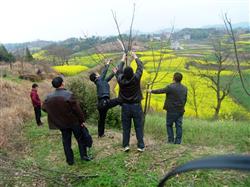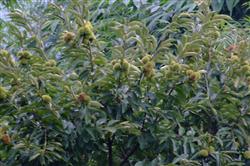How to trim the chestnut tree?

How to trim the chestnut tree? Please give guidance to chestnut trees can refer to the following methods for pruning: first, the tree shape of young tree pruning chestnut is mainly natural happy shape and trunk sparse layer shape. 1. Natural happy shape: this shape has no central stem, only 3 Mel 4 main branches, the natural trunk is oblique outward, the crown is short and open, which is conducive to ventilation and light, and is suitable for close planting. It is the best tree shape at present. The general requirements for plastic surgery are as follows: the dry height is 80ml 100cm, the three main branches with uniform distribution around the trunk are selected, and the main branches must be oblique outward, with an opening angle of 50rel and 60 °. From now on, the branches will be sent out from the main branches. Three branches with a certain distance and strong growth were selected and cultured into secondary main branches. Make the crown sparsely open, ventilated and transparent, with three-dimensional results. 2. Trunk sparse layer shape: this shape has central trunk, 7 main branches and 3 layers. 1.2ml 1.5 meters between layers, 2 on the second floor and 1 on the third floor. Three secondary main branches were retained on each main branch. Coring is usually when the new shoot grows to about 30 cm, remove the tip 3 Mel 5 cm long shoot. After coring, the tip 3 Mel 5 buds germinate and grow again, or the single bud germinates uniaxially. Wheel marks are formed at the coring, and 5 buds below the wheel marks are the center of nutrition distribution before the germination and growth of the second shoot, and several large buds can be formed, and even flower buds can be formed in varieties with early fruit. After picking the heart for many times, the 3mur5 buds under the wheel marks of all branches have the same characteristics. According to the survey: the proportion of the fourth branch forming the fruiting mother branch is 35%, 56%, or even 90%. This brings convenience to winter pruning. For plastic surgery, it can be cut to any first branch without affecting the fruit and crown growth of the second year. It usually doesn't pick up the heart after the middle of August. When pruning in winter. It is very important to prune the extension of the main branch. There are generally 5 happy-shaped main branches. Each main branch should keep a certain distance and try to avoid 5 strong branches from the top as backbone branches at the same time. With the growth of the tree, the branches increase year by year, and the selected main branches should grow in an oblique direction, non-overlapping, staggered and divergent, which is beneficial to ventilation and light transparency. the selected main branch should be in the full bud short section of the branch 40ml 50cm to promote the main branch branch. Due to top advantage. Under the cut, the first bud produces a strong leading branch, which extends outward to expand the crown. If the angle of several strong branches at the top of the main branch is too small, the strong branches in the middle can be removed and the function of the crown can be extended outward. In the process of pruning young trees, because of the large amount of pruning, the hidden buds of the trunk often sprout long branches, which are strong and upright. The overgrown branches that affect the main branches and disrupt the tree shape should be removed in time. The overgrown branches growing in the bald position can continuously pick the heart in summer, promote the branches and transform them into fruiting branches. Except that the main branches and lateral branches of the main branches play a backbone role, the other branches can be treated as auxiliary branches. 2. Pruning of fruiting trees 1. Pruning of fruiting mother branches: most of the one-year-old branches that grow strongly around the crown should be retained; when they are too dense and overlap, the weaker ones should be thinned, and the overgrowing fruiting mother branches should be left one or two under them to cultivate into new fruiting mother branches. When the mother branch tends to weaken due to successive years, it should be retracted, and a new fruit mother branch should be cultivated below to replace it. All the thin and weak branches that occur in the attachment of the weak fruiting mother branch should be removed as soon as possible, so that the nutrients are concentrated and supplied to the mother branch, so that it becomes weak and strong. The weak plants tend to have more weak branches and less fruiting mother branches, so some weak branches should be removed to promote the formation of new fruiting mother branches. For general weak branches or male flower branches, they can be truncated or retracted to promote the transformation of the cut bud or the branch below the cut into a new fruiting mother branch. 2. Pruning of male flower branches: due to the blind nodes caused by male inflorescences, the fruit parts are moved outward, so for male flower branches above lO cm, the base 2 buds are cut short: short, thick male flower branches not more than lO cm or full terminal buds, fruiting branches can be drawn the following year, but not pruned. 3. Vegetative branch pruning: for vegetative branches with a length of more than 30 cm, because the buds in the lower part of them only produce weak branches or no branches, the fruit is often moved out, so 2 buds should be cut short at the base to promote new fruiting mother shoots; strong vegetative branches with a length of less than 20 cm can be thrown away without pruning. 4. Pruning the fruiting branch after fruit harvest: if the tail branch is strong and the bud is full and full, it should be treated according to the method of the mother branch of the above treatment. If the tail branch is thin and weak, and the bud is not full, it should be treated as follows: if the lower part of the fruit branch has developed a new fruit mother branch, it should be left as a new fruit mother branch, and the upper fruit mother branch should be cut off together with the old mother branch. If the lower part is a vegetative branch, it can also be cut according to the method of vegetative branch; if the lower part is neither fruiting nor vegetative branch. A fruiting branch close to the backbone branch can be left and its stem 2 buds truncated. 5. Control and utilization of growing branches: slow release of growing branches that are not growing well. Flower buds can be formed in the following year; for strong and prosperous long branches with a length of more than 30 cm. It should be coring first in summer, cut short in winter, promote branching, strong and weak in the following year, go straight and stay oblique; for the overgrown branches that occur at the base of the main branches of weak trees, they should be retained as regeneration branches. The above is the general method of winter pruning. Summer pruning through the use of two measures, one is to wipe buds, when sprouting, strong branches leave 4 Mel 5 big buds. Erase the rest of the buds. To promote the growth of fruit branches and increase the number of male flowers; second, except for males, when the male inflorescence is less than 2 cm, except for the 5 male inflorescences at the apex of fruit branches, the rest are erased. Click to get more chestnut planting techniques click to get more fruit planting techniques
- Prev

How to control the chestnut peach borer?
How to control the chestnut peach borer? Please give guidance to Pyralidae, which belongs to Lepidoptera. The larvae eat chestnut fruit, accumulate insect droppings in the seeds, which is unedible, and cause fruit drop, which has a great impact on the yield and quality. The host also has peach, plum, pear fruit, sunflower disk, corn stalk and so on. Form.
- Next

How to apply biogas manure to chestnut trees
How do chestnut trees apply biogas manure? Please introduce that the growth of Chinese chestnut requires nitrogen, phosphorus, potassium, calcium, iron, boron and other nutrient elements, and requires the soil to be permeable and breathable, with good performance of water and fertilizer conservation. Growing Chinese chestnut with biogas fertilizer can meet most of the nutrients needed for its growth. biogas fertilizer is rich in nitrogen, phosphorus, potassium, calcium, magnesium, iron and so on.
Related
- Moge, come on! The staff of the peasant association in the producing area of cantaloupe were frightened when the crowd gathered.
- Causes and Solutions of low Fruit setting rate of Apple
- Symptoms and control measures of passion fruit virus disease
- Fruit growing lesson: how do apple orchards keep high yields?
- Can you build orchards in the mountains? What are the pros and cons?
- How to manage the coloring period of Crisson grape?
- This paper introduces the processing technology of two kinds of fig products.
- How much is a month for retired teachers in rural areas by 2020?
- How can strawberry planting increase sugar content? We should pay attention to management in many aspects.
- What are the cultivation techniques on how to improve the yield of golden fruit?

